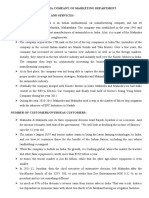0 ratings0% found this document useful (0 votes)
33 viewsFord Case Assingment-2: UR21043-Ritvik Kashyap
Ford Case Assingment-2: UR21043-Ritvik Kashyap
Uploaded by
Priyam MrigFord Motor Company grew rapidly in its early years, producing 100 cars daily by 1908. Henry Ford wanted to increase production to 1,000 cars per day but faced lawsuits from stockholders concerned it would reduce their dividends. The Dodge brothers, who supplied Ford with chassis, also sued Ford for cutting prices which reduced stockholder dividends. During the trial, Ford explained his vision of maximizing profits for employees and customers rather than just stockholders. The court initially sided with the Dodge brothers. In response, Ford bought out all stockholders so he could have full control over the company's vision and strategy. He created a new corporation and pursued vertical integration by acquiring raw material suppliers and factories to gain more control over the production process
Copyright:
© All Rights Reserved
Available Formats
Download as DOCX, PDF, TXT or read online from Scribd
Ford Case Assingment-2: UR21043-Ritvik Kashyap
Ford Case Assingment-2: UR21043-Ritvik Kashyap
Uploaded by
Priyam Mrig0 ratings0% found this document useful (0 votes)
33 views2 pagesFord Motor Company grew rapidly in its early years, producing 100 cars daily by 1908. Henry Ford wanted to increase production to 1,000 cars per day but faced lawsuits from stockholders concerned it would reduce their dividends. The Dodge brothers, who supplied Ford with chassis, also sued Ford for cutting prices which reduced stockholder dividends. During the trial, Ford explained his vision of maximizing profits for employees and customers rather than just stockholders. The court initially sided with the Dodge brothers. In response, Ford bought out all stockholders so he could have full control over the company's vision and strategy. He created a new corporation and pursued vertical integration by acquiring raw material suppliers and factories to gain more control over the production process
Original Title
UR21043_STM
Copyright
© © All Rights Reserved
Available Formats
DOCX, PDF, TXT or read online from Scribd
Share this document
Did you find this document useful?
Is this content inappropriate?
Ford Motor Company grew rapidly in its early years, producing 100 cars daily by 1908. Henry Ford wanted to increase production to 1,000 cars per day but faced lawsuits from stockholders concerned it would reduce their dividends. The Dodge brothers, who supplied Ford with chassis, also sued Ford for cutting prices which reduced stockholder dividends. During the trial, Ford explained his vision of maximizing profits for employees and customers rather than just stockholders. The court initially sided with the Dodge brothers. In response, Ford bought out all stockholders so he could have full control over the company's vision and strategy. He created a new corporation and pursued vertical integration by acquiring raw material suppliers and factories to gain more control over the production process
Copyright:
© All Rights Reserved
Available Formats
Download as DOCX, PDF, TXT or read online from Scribd
Download as docx, pdf, or txt
0 ratings0% found this document useful (0 votes)
33 views2 pagesFord Case Assingment-2: UR21043-Ritvik Kashyap
Ford Case Assingment-2: UR21043-Ritvik Kashyap
Uploaded by
Priyam MrigFord Motor Company grew rapidly in its early years, producing 100 cars daily by 1908. Henry Ford wanted to increase production to 1,000 cars per day but faced lawsuits from stockholders concerned it would reduce their dividends. The Dodge brothers, who supplied Ford with chassis, also sued Ford for cutting prices which reduced stockholder dividends. During the trial, Ford explained his vision of maximizing profits for employees and customers rather than just stockholders. The court initially sided with the Dodge brothers. In response, Ford bought out all stockholders so he could have full control over the company's vision and strategy. He created a new corporation and pursued vertical integration by acquiring raw material suppliers and factories to gain more control over the production process
Copyright:
© All Rights Reserved
Available Formats
Download as DOCX, PDF, TXT or read online from Scribd
Download as docx, pdf, or txt
You are on page 1of 2
UR21043- Ritvik Kashyap
----------------------------------------------------------------------------------------------------------------
Ford Case Assingment-2
In its first five years, Ford Motor Company produced eight car models; by 1908, it produced
100 cars daily. Ford considered raising output to 1,000 automobiles per day. Stockholders
were ecstatic. Shareholders discussed suing him to stop him from utilising profits to grow his
firm. In 1909, Ford, who owned 58% of the firm, announced he would only make the Model
T. Horace and John Dodge sued him in 1916 to protect their dividends from his imagination.
They had no choice.
The Dodge brothers, who had previously provided Ford chassis but were now constructing
their own automobile while still holding Ford shares, sued Ford for his reckless expansion
and for cutting product pricing, which diverted money from owners' dividends. Dodge
brothers owned Ford at the time. During judicial hearings, Ford discussed his business
beliefs. In December 1917, the court sided with the Dodges; Ford appealed, but was
unsuccessful. The court declared in 1919 that a company's principal job is to maximise profits
for its stockholders, not its employees and consumers. Ford was so angry that a court and a
few shareholders, whom he called parasites, might interfere with his company that he bought
out all of the shareholders. After standing down as president in December 1918 to make room
for his son Edsel, he declared in March 1919 his plan to found a new corporation to create
cheaper cars than the Model T. When asked what would become of Ford Motor Company, he
said, "I don't know; the part that doesn't belong to me can't be sold to me." (He can't buy the
company's non-his part.) After bringing him to court for mismanagement, the Dodges vowed
he'd never leave the family business. Ford said he'd start a new company if he couldn't
control his current one. Ford took out all seven minority owners by July 1919. The seven
received $106,000,000 for their stock, a court-ordered dividend of $19,275,385, and
$1,536,749 in interest. In 1920, Ford reformed under a Delaware charter. Henry Ford and
family owned all firm shares. Never before had one person ruled such a large commercial
firm.
Dodge sued because they were building a new plant in River Rouge, Michigan. Henry Ford
wanted absolute self-sufficiency, not just increased capacity. World War I's shortages and
price increases taught him the need of controlling his raw materials, and his suppliers'
inefficiencies led him to decide he should make his own components. Wheels, tyres,
upholstery, and other accoutrements came from Detroit-area manufacturers. As Ford's
production increased, these smaller companies needed to develop assembly lines to raise their
output. It became impossible to organise production and shipping so every product arrived on
time and in the right place. Initially, he tried to avoid manufacturing delays by stockpiling,
but he quickly realised this was a waste of money and abandoned it. Instead, he expanded
mobility to cover production and inventory. He thought his production costs began when the
raw material was removed and ended when the completed product was delivered. His River
Rouge factory realised his idea of an integrated production, assembly, and transportation
operation. To vertically integrate his enterprise, he bought a railroad, 16 coal mines, 700,000
acres of timberland, a sawmill, a fleet of Great Lakes freighters, and a glassworks.
From Highland Park to River Rouge, the factory moved in 1927. At 8 a.m., a Ford freighter
brought ore from Michigan and Minnesota mines. Ore would be delivered by conveyor to
blast furnaces, where it would be turned into steel using Kentucky coal. It went through
foundry moulds and stamping mills before becoming a finished car 28 hours after arriving as
ore. Similar processes handled flooring, tyres, etc. During its heyday, the company had iron
mines in northern Michigan and rainforests in Brazil and did business in 33 countries.
Surprisingly, none of it was paid with borrowed money. Model T sales funded everything.
Rubber plantations in Brazil, Coal mines in Kentucky, Timber forests and iron-ore mines in
Michigan and Minnesota a fleet of ships, a railroad, a glass works these all were vertical
integration. These all gave the competitive advantage to the ford motors. Because the time
taken in the supply chain would be less, hence low cost of travel and also the quality check of
the parts can be done easily and can be modified according to the needs of the company.
“In 1913, the company invented the world's first, which cut the amount of time needed to
assemble the product in half, from 12.5 hours to 2.7 hours. The time needed to complete this
task would be cut in half by subsequent advancements, taking only 1 hour and 33 minutes.
This is the organic integration done by the ford motors.” Because the definition of organic
integration is the need to integrate their passion with strategy, collaboration, and procedure
through a creative process known as organic integration in order to achieve the best results in
terms of achieving sustainable, quick growth with higher levels of fulfilment for everyone
involved in the endeavour.
You might also like
- The Subtle Art of Not Giving a F*ck: A Counterintuitive Approach to Living a Good LifeFrom EverandThe Subtle Art of Not Giving a F*ck: A Counterintuitive Approach to Living a Good LifeRating: 4 out of 5 stars4/5 (6016)
- The Gifts of Imperfection: Let Go of Who You Think You're Supposed to Be and Embrace Who You AreFrom EverandThe Gifts of Imperfection: Let Go of Who You Think You're Supposed to Be and Embrace Who You AreRating: 4 out of 5 stars4/5 (1112)
- Never Split the Difference: Negotiating As If Your Life Depended On ItFrom EverandNever Split the Difference: Negotiating As If Your Life Depended On ItRating: 4.5 out of 5 stars4.5/5 (908)
- Grit: The Power of Passion and PerseveranceFrom EverandGrit: The Power of Passion and PerseveranceRating: 4 out of 5 stars4/5 (619)
- Hidden Figures: The American Dream and the Untold Story of the Black Women Mathematicians Who Helped Win the Space RaceFrom EverandHidden Figures: The American Dream and the Untold Story of the Black Women Mathematicians Who Helped Win the Space RaceRating: 4 out of 5 stars4/5 (937)
- Shoe Dog: A Memoir by the Creator of NikeFrom EverandShoe Dog: A Memoir by the Creator of NikeRating: 4.5 out of 5 stars4.5/5 (546)
- The Hard Thing About Hard Things: Building a Business When There Are No Easy AnswersFrom EverandThe Hard Thing About Hard Things: Building a Business When There Are No Easy AnswersRating: 4.5 out of 5 stars4.5/5 (358)
- Her Body and Other Parties: StoriesFrom EverandHer Body and Other Parties: StoriesRating: 4 out of 5 stars4/5 (831)
- Elon Musk: Tesla, SpaceX, and the Quest for a Fantastic FutureFrom EverandElon Musk: Tesla, SpaceX, and the Quest for a Fantastic FutureRating: 4.5 out of 5 stars4.5/5 (479)
- The Emperor of All Maladies: A Biography of CancerFrom EverandThe Emperor of All Maladies: A Biography of CancerRating: 4.5 out of 5 stars4.5/5 (275)
- The Little Book of Hygge: Danish Secrets to Happy LivingFrom EverandThe Little Book of Hygge: Danish Secrets to Happy LivingRating: 3.5 out of 5 stars3.5/5 (434)
- The World Is Flat 3.0: A Brief History of the Twenty-first CenturyFrom EverandThe World Is Flat 3.0: A Brief History of the Twenty-first CenturyRating: 3.5 out of 5 stars3.5/5 (2281)
- The Yellow House: A Memoir (2019 National Book Award Winner)From EverandThe Yellow House: A Memoir (2019 National Book Award Winner)Rating: 4 out of 5 stars4/5 (99)
- The Sympathizer: A Novel (Pulitzer Prize for Fiction)From EverandThe Sympathizer: A Novel (Pulitzer Prize for Fiction)Rating: 4.5 out of 5 stars4.5/5 (125)
- Devil in the Grove: Thurgood Marshall, the Groveland Boys, and the Dawn of a New AmericaFrom EverandDevil in the Grove: Thurgood Marshall, the Groveland Boys, and the Dawn of a New AmericaRating: 4.5 out of 5 stars4.5/5 (273)
- A Heartbreaking Work Of Staggering Genius: A Memoir Based on a True StoryFrom EverandA Heartbreaking Work Of Staggering Genius: A Memoir Based on a True StoryRating: 3.5 out of 5 stars3.5/5 (232)
- Team of Rivals: The Political Genius of Abraham LincolnFrom EverandTeam of Rivals: The Political Genius of Abraham LincolnRating: 4.5 out of 5 stars4.5/5 (235)
- On Fire: The (Burning) Case for a Green New DealFrom EverandOn Fire: The (Burning) Case for a Green New DealRating: 4 out of 5 stars4/5 (75)
- Organic Vs Inorganic Growth 8b PDFDocument17 pagesOrganic Vs Inorganic Growth 8b PDFPriyam MrigNo ratings yet
- Cashbook Questions For PractiseDocument21 pagesCashbook Questions For Practisedona100% (3)
- The Unwinding: An Inner History of the New AmericaFrom EverandThe Unwinding: An Inner History of the New AmericaRating: 4 out of 5 stars4/5 (45)
- Enable - Complete Guide To Rebate ManagementDocument13 pagesEnable - Complete Guide To Rebate ManagementSilvia CastilloNo ratings yet
- Actors in The CaseDocument5 pagesActors in The CasePriyam MrigNo ratings yet
- Sand MiningDocument4 pagesSand MiningPriyam MrigNo ratings yet
- Ur20076 ManagementdecisioncaseDocument4 pagesUr20076 ManagementdecisioncasePriyam MrigNo ratings yet
- Ur20074 ManagementdecisioncaseDocument4 pagesUr20074 ManagementdecisioncasePriyam MrigNo ratings yet
- Drinking Water: Does Access To Water Mean Safety?Document3 pagesDrinking Water: Does Access To Water Mean Safety?Priyam MrigNo ratings yet
- Marketing Management: Assignment Title: Market Analysis of Vermicompost ProductDocument7 pagesMarketing Management: Assignment Title: Market Analysis of Vermicompost ProductPriyam MrigNo ratings yet
- Marketing Management Assignment: Submitted To: Prof. Indirah Indibara School of Rural Management, XIM UniversityDocument12 pagesMarketing Management Assignment: Submitted To: Prof. Indirah Indibara School of Rural Management, XIM UniversityPriyam MrigNo ratings yet
- Xavier University Mba-Rm Operations Management 2020-21, TERM-III End Term Examination-April 2021 Name .......... Roll Number InstructionsDocument2 pagesXavier University Mba-Rm Operations Management 2020-21, TERM-III End Term Examination-April 2021 Name .......... Roll Number InstructionsPriyam MrigNo ratings yet
- Marketing ManagementDocument5 pagesMarketing ManagementPriyam MrigNo ratings yet
- Annualreport2021 1Document96 pagesAnnualreport2021 1Priyam MrigNo ratings yet
- Water Conservation and Its Importance-Essay NRMDocument2 pagesWater Conservation and Its Importance-Essay NRMPriyam MrigNo ratings yet
- Group 9 - Essay 1Document6 pagesGroup 9 - Essay 1Priyam MrigNo ratings yet
- Assignment Solutions, Case Study Answer Sheets Project Report and Thesis ContactDocument6 pagesAssignment Solutions, Case Study Answer Sheets Project Report and Thesis ContactPriyam MrigNo ratings yet
- 納稅義務人 Taxpayer: 2020 Individual Income Tax Return Of The Republic Of ChinaDocument2 pages納稅義務人 Taxpayer: 2020 Individual Income Tax Return Of The Republic Of China妮妮No ratings yet
- Blomsma F 2017 PHD ThesisDocument323 pagesBlomsma F 2017 PHD ThesisadinamdarNo ratings yet
- SMETA 7.0 Member Manual Annex 3 - Exmaples of grading the MSA Elements August 2024 v1.0Document4 pagesSMETA 7.0 Member Manual Annex 3 - Exmaples of grading the MSA Elements August 2024 v1.0Luz Aida Montoya RamirezNo ratings yet
- Winning Finance Transformation Research ReportDocument18 pagesWinning Finance Transformation Research ReportCharles SantosNo ratings yet
- Riya BlackbookDocument69 pagesRiya BlackbookRiya PethadNo ratings yet
- For Personal Use Only (Ibanking) For Personal Use Only (Ibanking)Document1 pageFor Personal Use Only (Ibanking) For Personal Use Only (Ibanking)ေတ ဇာNo ratings yet
- 1.2 Assignment - TemplateDocument5 pages1.2 Assignment - Templatekeerthivasan19992No ratings yet
- 11 YueDocument3 pages11 Yuecooljoe10088No ratings yet
- Professional Communication (UHU003) Assignment 1: Name: Meghna Rai Roll Number: 101903033 Section: G2Document2 pagesProfessional Communication (UHU003) Assignment 1: Name: Meghna Rai Roll Number: 101903033 Section: G2Yash DhawanNo ratings yet
- 3.1. Mark-On, Mark-Down, Mark-Up and Margins: Questions To PonderDocument3 pages3.1. Mark-On, Mark-Down, Mark-Up and Margins: Questions To PonderVanessa Fampula FaigaoNo ratings yet
- Chapter 3Document19 pagesChapter 3omar maherNo ratings yet
- Cybersecurity_in_Accounting_Information_Systems_Ch (1)Document12 pagesCybersecurity_in_Accounting_Information_Systems_Ch (1)Safa Adel MohamedNo ratings yet
- Percentage-of-AmountsDocument16 pagesPercentage-of-AmountskanwalbirNo ratings yet
- 1-2021 FINMNN1 - 6 - WC and FD Problem Assessment: Bbcdbyes BaddbnoDocument2 pages1-2021 FINMNN1 - 6 - WC and FD Problem Assessment: Bbcdbyes BaddbnoMoreen VesquiraNo ratings yet
- Skims A3 Interview EditsDocument13 pagesSkims A3 Interview Editsapi-700551680No ratings yet
- MC DonaldDocument4 pagesMC Donaldsmilehubb01No ratings yet
- MTE LinkedIn Guide PDFDocument9 pagesMTE LinkedIn Guide PDFVaibhav GuptaNo ratings yet
- Essay On Green RevolutionDocument7 pagesEssay On Green Revolutionmekenedavuj3100% (2)
- Essay On PainterDocument7 pagesEssay On Painterfz6ff7m0100% (2)
- Jess 107Document13 pagesJess 107Parjanya SNo ratings yet
- BA7107-Legal Aspects of Business Question Bank - EditedDocument6 pagesBA7107-Legal Aspects of Business Question Bank - EditedUma UmamaheswariNo ratings yet
- Essentials of Communication: Md. Shahidullah KayserDocument35 pagesEssentials of Communication: Md. Shahidullah Kaysershk sunNo ratings yet
- Original For Recipient Tax Invoice: (Deepak Das)Document1 pageOriginal For Recipient Tax Invoice: (Deepak Das)Deepak DasNo ratings yet
- Food Service and Vending Business Marketing PlanDocument23 pagesFood Service and Vending Business Marketing PlanPalo Alto Software96% (27)
- Bule Hora University College of Business and Economics Department of Management MBA ProgramDocument3 pagesBule Hora University College of Business and Economics Department of Management MBA ProgramMinimax Mengistu100% (1)
- Mahindra and Mahindra Company of Marketing Department Mahindra of Products and ServicesDocument8 pagesMahindra and Mahindra Company of Marketing Department Mahindra of Products and ServicesCraft DealNo ratings yet
- King Faisal HospitalDocument11 pagesKing Faisal HospitalS S CreatingNo ratings yet
- MPR by Rishabh RajgopalDocument115 pagesMPR by Rishabh RajgopalMelodyo ZoneNo ratings yet




















































































